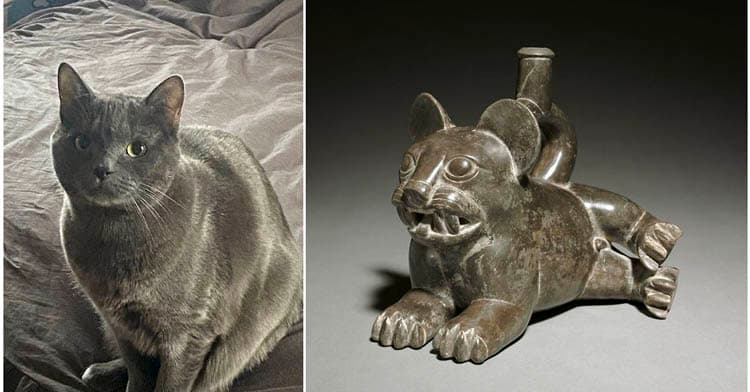
Transformation by Digitization
- Magazine Article
- Digital Innovation
The unique circumstances of the past year fast-tracked a digital transformation that was already well underway

Copy Cats AI finds friends in the collection
Over the past year, the museum has been unwavering in its commitment to creating new digital content and programs. Our ability to innovate through challenging times reflects the steps we’ve taken to bring our mission to “create transformative experiences, for the benefit of all the people forever” into the 21st century.
We began 2020 with the one-year anniversary of Open Access, an initiative that extends our collection beyond the museum’s walls and allows people across the globe to collaborate while reusing and remixing images. Meanwhile, the team focused on creating full-scale digital prototypes for the upcoming exhibition Revealing Krishna. Spanning centuries and continents and involving extensive art conservation and international relations, the exhibition’s stories would have been difficult to tell with artwork alone. This first-of-its-kind exhibition will incorporate immersive projections, interactive 3-D models, and a mixed-reality experience using Microsoft HoloLens 2, changing the perception of a “scholarly museum exhibition.” However, as we moved into March 2020, work on Revealing Krishna halted, and the exhibition was rescheduled for 2021.

On March 14, the reality of the pandemic took hold when the CMA closed to the public. Our cross-departmental team adapted quickly, pivoting to online toolsets (in addition to moving staff online and providing virtual programming). We took the opportunity to ask: What does the museum of the future look like? We challenged our team to conceptualize web-based initiatives to inspire, engage, and connect visitors. Immediately upon closure, use of our collection’s online platforms grew. In fact, from March to December, the museum saw a 153% increase in Open Access downloads compared to 2019. The shift to virtual engagement leveled the playing field: by being accessible online, being a Midwest museum no longer mattered and we could reach a wider audience.
Throughout 2020, the museum released multiple diverse and engaging online tools, bringing our world-class collection to visitors in new ways, with 10 exhibitions online, Keithley Gift screensavers, 6 new video series, 46 virtual member and public events, and toolsets like the Artificial Intelligence–based image search ArtLens AI, the remote work app ArtLens for Slack, and a Stories from Storage guide in the ArtLens App. Interactive live dashboards show the increased reach of the CMA’s Open Access collection—you can even catch a few CMA favorites, such as Cupid and Psyche, in Netflix’s Bridgerton.

The CMA’s digital innovations and achievements are the result of our dedication to digitizing the permanent collection, a major endeavor that the museum has been working toward for years. When I began my dream job at the CMA just over a decade ago, I encountered the perfect storm of events, which led to a revolution in the museum’s use of technology and the launch of Gallery One. The rapid advance and convergence of mobile technologies, combined with the completion of the building’s expansion, provided an opportunity ripe for transformation. Even before my arrival, the road to digitization had already begun. Mary Suzor, director of collections management, saw an opportunity to focus on object photography while the permanent collection galleries were being redone. This substantial push validated how key digitization is to the success of the CMA’s digital innovation.
With the collection at the heart of all we do, the team created a digital management policy and workflow to complete photography for all works of art. We have established a best-practice plan that tracks progress toward the goal of 100% digitization. We also created an integrated back-end system that updates all museum platforms every 15 minutes, from Collection Online to the ArtLens Gallery interactives.
Improvements to workflow increased the number of artworks we needed to photograph, but also provided valuable new images and information to scholars and art lovers alike.
Artworks often include multiple components, which need to be conserved, photographed, and inventoried individually. The Sèvres Porcelain Factory Soap Box and Sponge Box Set is an ideal example of this policy. An icon at the lower right corner of the image on Collection Online indicates that there are more detail images. With a single click, users can explore and study each element.
The collection is now more than 95% digitized, due to a standardized policy on what to capture for every object type, newer and faster cameras, and enhancements to the collection management system, which streamlined workflow and data entry. Our team continues to work toward our goal of 100% digitization within the year, providing weekly
assessments to measure progress across the collection.
Although we are still amid the pandemic, we are optimistic. Throughout this difficult year, the museum’s staff has been working tirelessly to share the digitized collection with visitors in ways that support the museum’s mission and its goals to meet the moment, such as through fostering conversations about race and social injustice and supporting educational needs. The CMA will continue to lead with new digital experiences for all, and we look forward to welcoming you to the digitally forward exhibition Revealing Krishna in November 2021.
Did You Know?
The filters and the Advanced search feature in Collection Online allow you to explore artworks utilizing multiple fields, from artist and year to citations, provenance, exhibition history, 3-D models, and more. These are stackable, so you can experiment with different combinations of filters—for example, ceramics currently on view or paintings in a past exhibition.
https://www.clevelandart.org/art/collection/search?search=popular
Under “Popular,” you can search the collection for artists who are female, African American, and LGBTQ+. Stack these with additional filters to discover surprising new favorites.